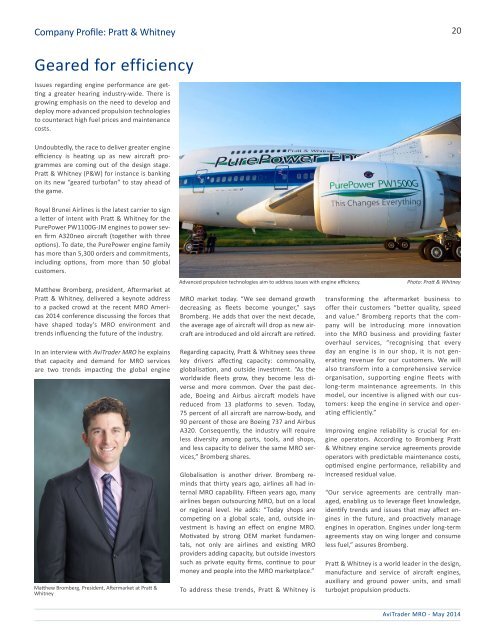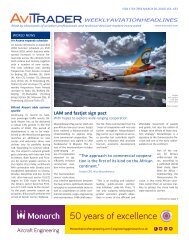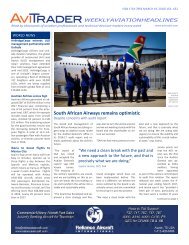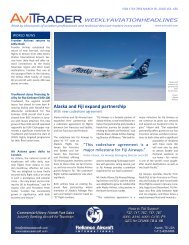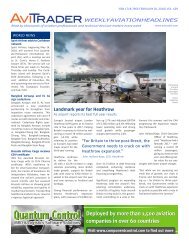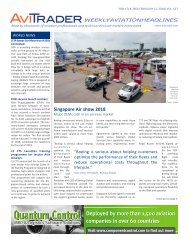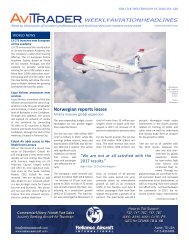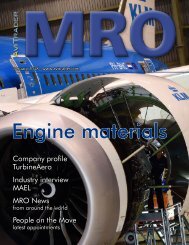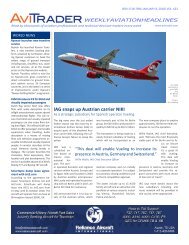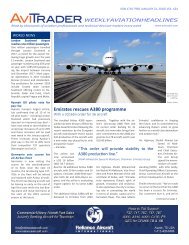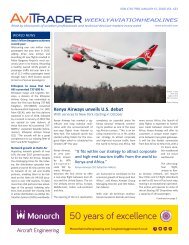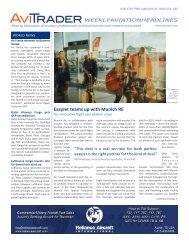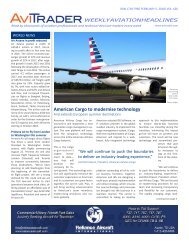AviTrader_Monthly_MRO_e-Magazine_2014-05
AviTrader_Monthly_MRO_e-Magazine_2014-05
AviTrader_Monthly_MRO_e-Magazine_2014-05
Create successful ePaper yourself
Turn your PDF publications into a flip-book with our unique Google optimized e-Paper software.
Company Profile: Pratt & Whitney<br />
20<br />
Geared for efficiency<br />
Issues regarding engine performance are getting<br />
a greater hearing industry-wide. There is<br />
growing emphasis on the need to develop and<br />
deploy more advanced propulsion technologies<br />
to counteract high fuel prices and maintenance<br />
costs.<br />
Undoubtedly, the race to deliver greater engine<br />
efficiency is heating up as new aircraft programmes<br />
are coming out of the design stage.<br />
Pratt & Whitney (P&W) for instance is banking<br />
on its new “geared turbofan” to stay ahead of<br />
the game.<br />
Royal Brunei Airlines is the latest carrier to sign<br />
a letter of intent with Pratt & Whitney for the<br />
PurePower PW1100G-JM engines to power seven<br />
firm A320neo aircraft (together with three<br />
options). To date, the PurePower engine family<br />
has more than 5,300 orders and commitments,<br />
including options, from more than 50 global<br />
customers.<br />
Matthew Bromberg, president, Aftermarket at<br />
Pratt & Whitney, delivered a keynote address<br />
to a packed crowd at the recent <strong>MRO</strong> Americas<br />
<strong>2014</strong> conference discussing the forces that<br />
have shaped today’s <strong>MRO</strong> environment and<br />
trends influencing the future of the industry.<br />
In an interview with <strong>AviTrader</strong> <strong>MRO</strong> he explains<br />
that capacity and demand for <strong>MRO</strong> services<br />
are two trends impacting the global engine<br />
Matthew Bromberg, President, Aftermarket at Pratt &<br />
Whitney<br />
Advanced propulsion technologies aim to address issues with engine efficiency.<br />
<strong>MRO</strong> market today. “We see demand growth<br />
decreasing as fleets become younger,” says<br />
Bromberg. He adds that over the next decade,<br />
the average age of aircraft will drop as new aircraft<br />
are introduced and old aircraft are retired.<br />
Regarding capacity, Pratt & Whitney sees three<br />
key drivers affecting capacity: commonality,<br />
globalisation, and outside investment. “As the<br />
worldwide fleets grow, they become less diverse<br />
and more common. Over the past decade,<br />
Boeing and Airbus aircraft models have<br />
reduced from 13 platforms to seven. Today,<br />
75 percent of all aircraft are narrow-body, and<br />
90 percent of those are Boeing 737 and Airbus<br />
A320. Consequently, the industry will require<br />
less diversity among parts, tools, and shops,<br />
and less capacity to deliver the same <strong>MRO</strong> services,”<br />
Bromberg shares.<br />
Globalisation is another driver. Bromberg reminds<br />
that thirty years ago, airlines all had internal<br />
<strong>MRO</strong> capability. Fifteen years ago, many<br />
airlines began outsourcing <strong>MRO</strong>, but on a local<br />
or regional level. He adds: “Today shops are<br />
competing on a global scale, and, outside investment<br />
is having an effect on engine <strong>MRO</strong>.<br />
Motivated by strong OEM market fundamentals,<br />
not only are airlines and existing <strong>MRO</strong><br />
providers adding capacity, but outside investors<br />
such as private equity firms, continue to pour<br />
money and people into the <strong>MRO</strong> marketplace.”<br />
To address these trends, Pratt & Whitney is<br />
Photo: Pratt & Whitney<br />
transforming the aftermarket business to<br />
offer their customers “better quality, speed<br />
and value.” Bromberg reports that the company<br />
will be introducing more innovation<br />
into the <strong>MRO</strong> business and providing faster<br />
overhaul services, “recognising that every<br />
day an engine is in our shop, it is not generating<br />
revenue for our customers. We will<br />
also transform into a comprehensive service<br />
organisation, supporting engine fleets with<br />
long-term maintenance agreements. In this<br />
model, our incentive is aligned with our customers:<br />
keep the engine in service and operating<br />
efficiently.”<br />
Improving engine reliability is crucial for engine<br />
operators. According to Bromberg Pratt<br />
& Whitney engine service agreements provide<br />
operators with predictable maintenance costs,<br />
optimised engine performance, reliability and<br />
increased residual value.<br />
“Our service agreements are centrally managed,<br />
enabling us to leverage fleet knowledge,<br />
identify trends and issues that may affect engines<br />
in the future, and proactively manage<br />
engines in operation. Engines under long-term<br />
agreements stay on wing longer and consume<br />
less fuel,” assures Bromberg.<br />
Pratt & Whitney is a world leader in the design,<br />
manufacture and service of aircraft engines,<br />
auxiliary and ground power units, and small<br />
turbojet propulsion products.<br />
<strong>AviTrader</strong> <strong>MRO</strong> - May <strong>2014</strong>


